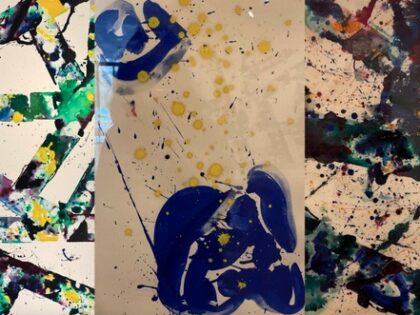Lately, I have been feeling like a Sally Rooney character: a little lost, a little gloomy, a little unsure about the decisions I have been making. So, I went to the Anderson Collection on a Saturday morning by myself, because museums have a calming effect on me. I needed to find my center again.
As I entered the Anderson Collection, I climbed up the stairs to reach the permanent collection. I was in the middle of a room surrounded by large canvases of colors. One of them, covering almost the entire wall, was simply a large pattern of burgundy, black and white. However, there was something very calming about looking at it. I used to criticize such artworks a lot, not understanding the value placed on artists like Rothko. But seeing such pieces in a museum in front of you feels very different than looking at images online after Googling the artist. These large canvases and colors, though they are just large patterns, weigh on you, and that weight was calming. It almost had an aura that transcended my mind from my real life, making me not ponder about the events of my daily life for a bit.
I was sitting down, and the painting on the wall next to it looked a lot like a Pollock painting. So I stood up to check the artist’s name, and it really was by Jackson Pollock — “Lucifer.” I started giggling to myself, because back home, you don’t just run into an actual Pollock piece. Instead, you run into pieces that were influenced by his style. That’s the thing I love about the museums in the U.S. — you see the works of the real names. In the Anderson household, “Lucifer” hung upon the wall over their daughter’s bed throughout her teenage years, as I read from a book in the gallery describing the Anderson collection. How lovely it must have been to wake up to the colors and the lines of “Lucifer” everyday.
There was a piece that looked like a Rorschach inkblot, a large chaotic dark shape on a white background. Like Rorshcach, who asked people to tell him what they were seeing in his famous inkblots, I questioned how to interpret this painting and thought about what was going on in the artist’s mind. Was he going through a chaotic period in his life? Is it fear he is trying to draw? Anger? I went up to read the description of “Figure 8” by Franz Kline, and learned that he was capturing the energy and the physicality of the act of drawing.
I walked through the rest of the rooms to find the painting I wanted to see before leaving the Anderson Collection. I had seen Richard Diebenkorn’s “Girl on the Beach” on the museum’s website, and I was drawn to it because it reminded me of a painting I loved from the summer, Roger Kunzt’s “Morning Thoughts.”
I actually never saw “Morning Thoughts” in real life, at least not yet. I had seen a performance of it at an arts festival in Laguna Beach over the summer. I had cried at that arts festival, while watching actors depict paintings in real life. I had seen a similar festival in an American TV series while growing up, and seeing a show with the same concept in real life had felt very strange. I am still not sure why I cried. I think I had almost felt out of place, like encountering an old dream I used to have in front of me.
Anyway, I loved the depiction of Roger Kunzt’s “Morning Thoughts” at that festival. Even though each painting’s depiction would last for only a few minutes, I had looked at it as deeply as I could to absorb every part of it through my eyes. I still remember that moment quite vividly. This painting at the Anderson Collection, Richard Diebenkorn’s “Girl on the Beach,” had reminded me of it. “Girl on the Beach” was larger in real life than I was expecting it to be, and it was very elegant, very summery. It reminded me of the summer days I had with my friend Analiese in Southern California. I wondered if Diebenkorn’s and Kunzt’s life paths had ever crossed. Both were California artists that lived around the same time, with a similar art style. Diebenkorn was a part of the Bay Area’s figurative movement that rejected abstract expressionism — a movement that went back to drawing figures instead of abstract patterns in the 1950s.
I left the Anderson Collection with a new perspective of looking at modern art. I felt vibrant, calm and fresh. I felt as though I had found the repurposing balance I was looking for.






